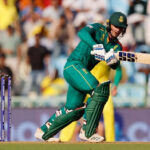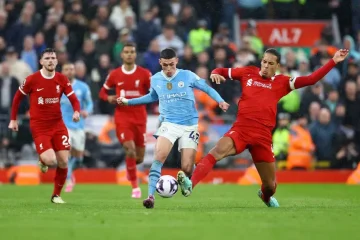DANIEL GALLAN
AIDEN Markram shattered more than just his wrist when he punched a door in Pune last year. After his second duck in a Test that India would go on to win by an innings and 137 runs, the 26-year-old from Centurion lashed out in frustration. Along with broken bones, he damaged a running narrative that this golden boy could do no wrong.
It was an important moment in Markram’s journey. The bullet points of his life portray a ride as smooth as his easy disposition and charming grin. From young prodigy to Under-19 ICC World Cup-winning captain, he had accelerated from dashing Proteas opener to the captain-elect in just a few months as an international cricketer. What’s more, he did so while presenting an image free from blemish.
This was not entirely cultivated by the man himself. Journalists and fans who have cooed at every cover drive and gasped at every pull through midwicket have been caught up in the narrative. Few make batting look beautiful and when he’s on song, Markram is one of them.
Then there’s his demeanour. When Proteas white-ball captain Quinton de Kock told ESPN’s The Cricket Monthly, “I’m never going to be the head boy,” he was talking about his own approach to leadership that juxtaposes that of the quintessential South African sports figurehead. De Kock does not share many traits that one might expect to find in an elected school prefect. Markram ticks just about every box.
A product of Pretoria Boys High School, he speaks eloquently and calmly. He carries himself with composure and looks you in the eye when answering your question, doffing his cap as he extends his hand for a firm shake. Senior voices in the Proteas camp, including Dean Elgar and Dale Steyn, have reported that when Markram speaks, others listen.
So when Faf du Plessis fractured his finger in the first of six one-day internationals (ODIs) against India in early 2018, few eyebrows were raised when Markram was given the armband. It didn’t matter that he had just turned 23 four months earlier. It didn’t matter that he had only represented his country in six Tests and two ODIs. Like Graeme Smith, who became Proteas captain at 22, Markram was seemingly born to lead.
Against the intense heat radiating from Virat Kohli, Markram wilted. India’s spin twins Kuldeep Yadav and Yuzvendra Chahal bamboozled the Proteas batters and collected 33 wickets between them over six matches. Kohli was at his imperious best, hitting three centuries and ending the series with an average of 186. Apart from one rain-affected match, which South Africa edged by five wickets, India won every game with fuel to burn. Markram appeared out of his depth.

“I thought at the time it was a bad decision to make Aiden captain,” says Pierre de Bruyn, Namibia’s head coach and a close friend of the family for years, first as a next-door neighbour and then as Markram’s coach at the University of Pretoria. “I literally stood still when I heard the news. I could not believe it. I was really worried.”
It wasn’t that De Bruyn thought leadership was beyond Markram. On the contrary, he says the young man who remains the only South African to lift an ICC World Cup as captain has all the raw ingredients necessary for the job. It’s that he feared what might happen if things went awry. Would Markram be able to separate his team’s failures from his own insecurities?
“He gets very down on himself when he’s not doing well,” De Bruyn says. “He’s always been like that. It’s not that he has too much pride, though he is ambitious and wants to do well on a personal level. It’s that he feels he is letting others down when he doesn’t achieve his goals.”
Coming up when the Proteas were going down
Markram was left out of the subsequent Twenty20 fixtures against India, allowing him to refresh for the incoming Australians. In a fiercely contested Test series forever marked by the ball-tampering fiasco in Cape Town, Markram acquitted himself with distinction. Having registered a battling 143 in Durban that almost saved the Test, he unfurled 152 of the most elegant runs you’ll hope to see at the Wanderers. That he made AB de Villiers look like the less accomplished partner exacerbated the excitement.
That would be Markram’s last century for his country. A 90 against Pakistan in a one-sided Test in January 2019 is as close as he’s come since. In his first 10 Tests, including that grandiose display in Johannesburg, his average was 55.55. In the 10 since, it’s 22.31.
To be fair to Markram, the first chapter of his career coincided with the fading glow of South Africa’s golden generation. There was De Villiers, flirting with a renaissance. There was Morne Morkel and Vernon Philander, still causing havoc in their irreplaceable ways. There was Hashim Amla, offering guidance and class in the top order.
All four are gone. Du Plessis has relinquished his duties as captain. De Kock now shoulders more responsibility with the bat. Kagiso Rabada, still only 25 years old, is the spearhead of the attack but has yet to fill the boots left by Dale Steyn.
This is a side in transition that has been further hamstrung by the perennial ineptitude of Cricket South Africa (CSA) and a painful culture war that has finally shone a light on cricket’s struggle with unchecked racial inequities. This would be a difficult environment for a player able to tune out the chaos around him. Markram can’t help but turn his ear to the noise.
“Everyone with an opinion on cricket in South Africa has an opinion on Aiden,” De Bruyn says. “Should he captain? Should he open? Should he bat at number four? What sort of white ball player is he? Should he bowl more? Aiden is a people pleaser. The more opinions about him, the more he feels he has to prove. It has confused the living daylights out of him.”
Of all the questions posed, the one concerning captaincy is perhaps the most hotly contested. De Bruyn says that the added responsibility would weigh heavily on Markram. “Let him just bat and find his smile again,” De Bruyn says, the care in his voice carrying a parentally pleading tone.
‘2019 was difficult’
Ray Jennings is someone in the opposing camp. The former South Africa wicketkeeper and coach who was in charge of the victorious Under-19 squad in 2014 says the best of Markram is revealed when he is placed under pressure.
“He is the sort of guy who performs better the more responsibility he has,” Jennings says. “He is a very caring person. He knows that the captain can’t exist in his own cocoon, that he has responsibilities outside of himself. Captains behave differently even if they’re burning inside like everyone else. I don’t think he would have punched that door if he was captain. He’ll definitely learn from that.”
Markram has been keen to draw a line under a tumultuous 2019. Before he broke his wrist in Pune, he contributed 140 runs at 23 from six innings in South Africa’s worst ever World Cup. In his return match against England in the first Test in Centurion, where he made 20 and two, he sustained a fractured finger while fielding. The required surgery put him out of action for a further six weeks.
By the time he had healed, the world had gone into lockdown because of Covid-19. In cricket’s absence, the CSA’s board unravelled. Lungisani Ngidi answered a question about the importance of black lives and opened a polarising discourse. As the madness unfolded, Markram found room to breathe.
“I enjoyed the break. It’s been a chance to do some reflection and also get the hunger levels back up there,” Markram said. “2019 was difficult. There were naturally disappointments, but those who know the game and who have played the game understand that cricket will always have the odd disappointment here and there. It’s part and parcel of the job.”
Markram echoes De Bruyn’s sentiment when he speaks of a “build-up of frustrations” as a reason for his violent outburst in Pune. “I really want to do well for the team and contribute to winning games,” he said. “When I don’t do that, I do get angry, yes. It’s human nature to get frustrated. I think few people are able to just laugh it off. I think I’ve calmed down over the last while, though, realising that I don’t want to unsettle the change room and the batters that are still yet to bat.”
Fighting his way back into the Proteas
His first serious knock for eight months came on 2 November in Cape Town. Opening for his domestic franchise, the Titans, he was tasked with seeing out the final four overs of the day following a first-innings declaration from the Cape Cobras. George Linde’s left-arm finger spin pushed Markram so far back in his crease that his heel made contact with the base of the stump. He was out “hit wicket” for just two.
He struck a breezy 48 in the second innings that also saw his old university teammate, Theunis de Bruyn, hit 127 in a successful chase of 316. When new CSA convenor of selectors Victor Mpitsang announced the Proteas white ball squad for England’s incoming tour, Markram’s name was not included.
“Aiden’s task now is to find consistency and re-establish himself as an international player, especially in limited-overs cricket,” De Bruyn says. “And once he gets back there, he has to find a way of staying there. But he’ll be okay. He’s a hell of a player and one bad year doesn’t change that.”
A few weeks after that dismissal of his own making, Markram reeled off a series of scores that once again had fans and journalists giddy with anticipation. The stars were seemingly realigning. Perhaps the prophecies would come true.
He began with twin hundreds – 149 and 121 – against the Warriors in late November. He greeted December with 113 runs against the Cobras. Against the Dolphins his march to a fourth century from as many innings was cut short at 75 courtesy of a superb catch in the gully by Proteas teammate Andile Phehlukwayo.
A spate of coronavirus scares curtailed the domestic season and prevented any further franchise cricket being played in 2020. Markram’s next outing, if healthy and selected, will come against Sri Lanka on Boxing Day at Centurion. That he’ll be taking guard on the same ground where he scored those three hundreds, as well as the 75 against the Dolphins, will fill him with confidence.
Despite the recent run glut, it has been a difficult 18 months for Markram. One’s perception of him should not change, at least not in any major way, because of what occurred during a period that most associated with cricket in South Africa would like to forget. But perhaps it can dispel the mythology that Markram has yet to live up to.
He may yet go on to achieve all that once looked preordained. He may yet guide the Proteas to the promised land and lift a senior World Cup as captain. He may yet scythe his way to the summit of the batting rankings, surmounting De Villiers, Amla and Jacques Kallis as the greatest willow-wielder in South Africa’s history.
He may not achieve any of that. He may play out the rest of his career with respectability but not much else. He might call it quits with a Test average in the low 40s and just enough white ball action to keep him in conversations around tournament squads. That would hardly constitute a failure. Most who play this sport could only dream of such mediocrity at the elite level.
Whatever path Markram walks from here, he must walk it himself. From the wreckage of one shattered image, the opportunity to create another has emerged.














